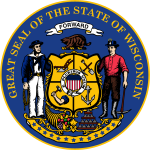| ||||||||||||||||||||||||||
| ||||||||||||||||||||||||||
 County Results
| ||||||||||||||||||||||||||
| ||||||||||||||||||||||||||
| Elections in Wisconsin |
|---|
 |
The 1952 United States presidential election in Wisconsin was held on November 4, 1952 as part of the 1952 United States presidential election. State voters chose 12 electors to the Electoral College, who voted for president and vice president.
Politics in Wisconsin since the Populist movement had been dominated by the Republican Party.[2] The Democratic Party became uncompetitive away from the Laue Michigan coast as the upper classes, along with the majority of workers who followed them, fled from William Jennings Bryan's agrarian and free silver sympathies.[3] Although the state did develop a strong Socialist Party to provide opposition to the GOP, Wisconsin developed the direct Republican primary in 1903 and this ultimately created competition between the "League" under Robert M. La Follette, and the conservative "Regular" faction.[4] This ultimately would develop into the Wisconsin Progressive Party in the late 1930s, which was opposed to the conservative German Democrats and to the national Republican Party, and allied with Franklin D. Roosevelt at the federal level.
During the two wartime elections, the formerly Democratic German counties in the east of the state – which had been powerfully opposed to the Civil War because they saw it as a "Yankee" war and opposed the military draft instituted during it[5] – viewed Communism as a much greater threat to America than Nazism and consequently opposed President Roosevelt's war effort.[6] Consequently, these historically Democratic counties became virtually the most Republican in the entire state, and with the fall of the Progressive Party that had provided the main opposition to the Republicans in the 1930s, the state sent an all-Republican congressional delegation to the 80th Congress for the first time since the 71st, and Democratic representation in the state legislature reached the lowest level since that same date, although it improved to a quarter of the state House in 1950.
During the second term of now-unpopular President Truman, populist conservative Wisconsin Senator Joe McCarthy became notorious for his investigations into Communists inside the American government. It was thought that he would be a hindrance both to Democratic nominee Adlai Stevenson II, and to Republican nominee Dwight D. Eisenhower.[7] Stevenson would call for McCarthy's defeat during his campaign in the state because he thought Eisenhower was using unfair political tactics,[8] that Eisenhower was a "scaremonger",[9] and that the Republican Party was the "Same Old Political Hokum".[10]
Polls in the state during the third week of October showed that most voters were for Eisenhower, although it was thought Stevenson was gaining.[11] The poll however said that if Stevenson was to carry Wisconsin he would be required to win over a large majority of undecided voters.[11] The probability of Stevenson achieving this was made more remote by a poll near the end of October that showed him trailing Eisenhower amongst Wisconsin's farmers by a two-to-one margin.[12]
- ^ "U.S. presidential election, 1952". Facts on File. Archived from the original on October 29, 2013. Retrieved October 24, 2013.
Eisenhower, born in Texas, considered a resident of New York, and headquartered at the time in Paris, finally decided to run for the Republican nomination
- ^ Burnham, Walter Dean; 'The System of 1896: An Analysis'; in The Evolution of American Electoral Systems, pp. 178-179 ISBN 0313213798
- ^ Sundquist, James; Politics and Policy: The Eisenhower, Kennedy, and Johnson Years, p. 526 ISBN 0815719094
- ^ Hansen, John Mark; Shigeo Hirano, and Snyder, James M. Jr.; 'Parties within Parties: Parties, Factions, and Coordinated Politics, 1900-1980'; in Gerber, Alan S. and Schickler, Eric; Governing in a Polarized Age: Elections, Parties, and Political Representation in America, pp. 165-168 ISBN 978-1-107-09509-0
- ^ Phillips, Kevin P.; The Emerging Republican Majority, pp. 381-382, 414 ISBN 978-0-691-16324-6
- ^ Phillips; The Emerging Republican Majority, pp. 387-388
- ^ Phillips, Cabell; 'M'Carthy POSPoses Problems for Both Parties: His Wisconsin Sweep Will Embarrass Eisenhower, Aid Foes of Stevenson'; The New York Times September 14, 1953, p. E3
- ^ Reston, James; 'Stevenson Scores Rival on M'Carthy in Wisconsin Talks: Calls for Defeat of Senator, Sees Eisenhower's Support Showing Lack of "Backbone"'; The New York Times, October 9, 1952, p. 1
- ^ Folliard, Edward T.; 'Adlai Calls Eisenhower Scaremonger On Red Issue: McCarthy Hasn't Caught a Communist, Governor Declares; Jibes at Hecklers Stevenson Goes After Eisenhower, McCarthy'; The Washington Post, October 8, 1952, p. 1
- ^ 'Text of Governor Stevenson's Talks at Madison and Milwaukee: Governor Criticizes G. O. P. Program as "Same Old Political Hokum"'; The New York Times, October 9, 1952, p. 26
- ^ a b Hagerty, James A.; 'Survey Sees Stevenson Gain With Outcome Still Uncertain: Nation-Wide'; The New York Times October 20, 1952, p. 1
- ^ 'Wisconsin Farm Poll Favors Eisenhower'; Special to The New York Times, October 29, 1952, p. 23


